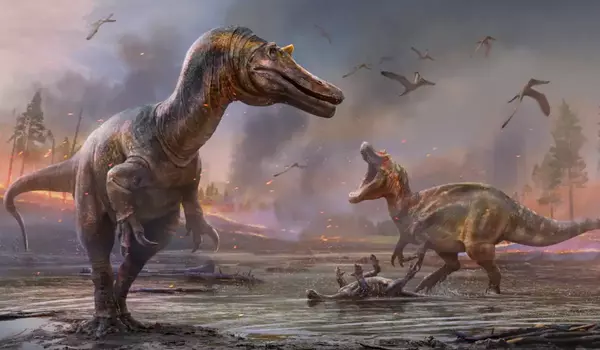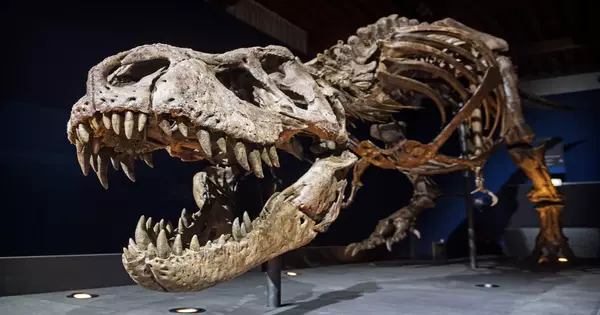- One peculiar aspect of this spectacular and well-known dinosaur is its unusually small arms.
- According to a paleontologist, numerous T. rexes fighting over the same cadaver could have resulted in calamity.
- This theory is based on evidence that predatory dinosaurs’ heads and forearms, particularly tyrannosauroids, evolved in lockstep.
How long are the arms of a typical adult? Of course, the length can vary, but on average, a human man’s wingspan is two inches greater than his height, while a woman’s is half an inch longer. Despite its 45-foot length and towering height of 12 feet, Tyrannosaurus rex, possibly the most well-known dinosaur, has curiously small arms. Our arms would be only five inches long if we had the same proportions.
So, how did such a massive monster have forelimbs that were barely three feet long—shorter than the arms of certain basketball players? Since 1902, when legendary dinosaur hunter Barnum Brown uncovered the first “fairly complete” T. rex skeleton in Hell Creek, Montana, paleontologists have been puzzled by this mismatch. Since its discovery, the short-armed dinosaur has been the brunt of jokes in popular culture favorites like the Toy Story films, in which a toy plastic replica dubbed Rex suffers from anxiety.
Their short limbs were presumably a survival feature for the actual dinosaurs, whose Latin name means “King of the Tyrant Lizards.” According to evolutionary biologist Kevin Padian of the University of California, Berkeley, they likely dined on carcasses together.
“What if a group of adult tyrannosaurs came together to eat a carcass?” You have a swarm of huge skulls ripping and devouring flesh and bone right next to you, with immensely powerful jaws and fangs. What if one of your friends thinks you’re becoming too close? “They might sever your arm to scare you away,” Padian speculates. Imagine the pain of having your bones crushed by those teeth, he says. It would have been a horrible death with a lot of blood loss and infection.
Padian’s hypothesis, which was just published in the journal Acta Palaeontologia Polonica, explains his reasoning. For some reason, Tyrannosaurid forerunners had larger arms, which had to be shortened for a reason, according to Padian, a curator at the University of California Museum of Paleontology. “Reducing the forelimbs could be beneficial, since you’re not utilizing them for predation anyhow.”

According to Padian, this adaption created other Cretaceous species, including the African and South American abelisaurids from the mid-Cretaceous, as well as the carcharodontosaurids, which were even bigger than T. rex and roamed Europe and Asia in the early and mid-Cretaceous periods.
It’s impossible to back up a theory about an extinct animal that lived 66 million years ago. On the other hand, T. rexes are thought to have possessed such predatory prowess, with six-inch teeth and powerful jaws, as well as heads up to five feet long, that fighting over the same prey presented a serious threat, according to Padian.
Dilong, the earliest known tyrannosauroid, was significantly smaller, measuring only three to six feet in length and having forelimbs that were more than half the length of its hindlimbs. In general, examinations of T. rex forerunners and other predator dinosaur species suggest that as their skulls, teeth, and other predatory characteristics became more prevalent, their forelimbs shrank. In the face of such frightening teeth, predators’ arms, which may have fed in packs, became a liability at some point.
“What if several adult tyrannosaurs converged on a carcass? You have a bunch of massive skulls, with incredibly powerful jaws and teeth, ripping and chomping down flesh and bone right next to you. What if your friend there thinks you’re getting a little too close? They might warn you away by severing your arm,”
Padian says
Because of its enormously disproportionate arm proportions, the T. rex remains an oddity. (Albertosaurid dinosaurs have arms that are proportionally smaller.)
There are exceptions to this rule. Deinonychus and its relatives, such as the massive Utahraptor, hunted in packs as well and grew longer, taller skulls with fewer (but larger) teeth. Despite this, they retained their lengthy arms, which were topped with sharp claws that were especially effective at eliminating animals (their Latin name means “awful claw”). In an email to Popular Mechanics, Padian said, “It’s commonly acknowledged that their bite force would have been less than that of T. rex, but then everyone’s was.”
Paleontologists have proposed a variety of theories for T. rex’s tiny and feeble arms, which evolved to lose both length and joint mobility over the last 150 years.
According to Padian, some of these concepts include social signaling, waving to attract a mate, functioning as an anchor to get off the ground, holding down prey, stabbing opponents, and even pushing a sleeping Triceratops over at night. The male T. rex’s arms were once thought to be used to hold a female in place during mating, but Padian argues the arms would have been too short and weak to exert any control.
“All of the proposed solutions are either untested or impossible to implement because they don’t work.” And none of the hypotheses could explain why the arms would shrink; the best they could do was explain why they would stay small. And in every case, if the arms had not been lowered, all of the planned functions would have been far more successful, “he says.





